BY HENRY SHEEHAN
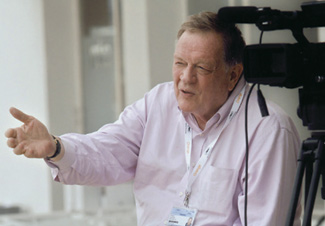 Schickel didn't have a theme when he started to work on
Schickel didn't have a theme when he started to work on
his documentary in 2007. (Credit: Warner Bros.)Thirty books, thirty-plus documentaries. That's a pair of numbers that might surprise even longtime fans of film critic Richard Schickel, who has been a fixture on the national film scene since he started out as Life magazine's film critic in 1965 (he moved over to Time in 1972, where he's been since). Most every cinephile knows his magazine output has been accompanied by a stream of books, most of them about movies, including critical biographies of Clint Eastwood, Elia Kazan, Woody Allen, and D.W. Griffith.
But Schickel has been making movies about movies and moviemakers nearly as long as he's been writing about them. You Must Remember This, a five-hour history of the 85-year-old Warner Bros. studios, which will kickoff PBS' American Masters series in September, is only the latest in what is Schickel's occasionally groundbreaking, always intriguing parallel career.
"I first got involved with making movies in the late '60s with PBS in New York," recalls Schickel. "They hired me to write some narration for two shows they were doing on Hollywood in the '30s and'40s. I found I liked the process of working on those films. I liked going into the cutting rooms and helping to shape stuff. Anyway, it was in the course of making those films that I met William Wellman and Howard Hawks and Raoul Walsh. I said to one of these people [at PBS], 'They're really good directors, all of them. We ought to do a series about them.' And somehow we got some backing for it and that became the The Men Who Made the Movies series. [The films I'm doing] now are much better; I didn't know what I was doing then."
Schickel began work on the Warner Bros. film in the spring of 2007, confident of two things: that the material–clips from movies accompanied by interviews–was easily accessible. And secondly, that it would be fairly difficult to organize.
"I think of the film as an oxymoron: It's an epic clip show," Schickel says one day in his Beverly Hills office. "The clip show is a humble form, but this one has an epic scope to it. It's 85 years, it's hundreds of people, it's hundreds of movies. At some point, its scale transcends its format."
Some of the organizing principles Schickel settled on were not difficult, and followed along chronological lines. The first two hours start off with the studio's foundation in 1923 by brothers Harry, Jack, Albert and Sam Warner and continues on up through the late 1940s. Then comes an hour dedicated to the 1950s and the end of "old Hollywood" in the mid-'60s. Part four covers the Steve Ross and Robert Daley-Terry Semel eras, while the final episode takes us up to the present day.
Unfortunately, history–even movie history–doesn't always fit into tidy packages.
"The biggest problem we had there is that film is obviously linear," Schickel explains. "But there's a lot of simultaneity at Warner Bros. At the same time, they're trying to bring on Cagney, they're also having this slightly dicey relationship with Bette Davis involving her misadventures trying to break her contract. She's leaving and then coming back in Marked Woman (Lloyd Bacon, 1937). And Errol Flynn is coming along at the same moment. So the question is, where do you put Errol Flynn in relationship to Bette Davis and in relationship to Jimmy Cagney, etc., etc. A lot of that is a little bit arbitrary. It's a question of how to put it into a linear form that has an historical arc to it. I think we did it reasonably well."
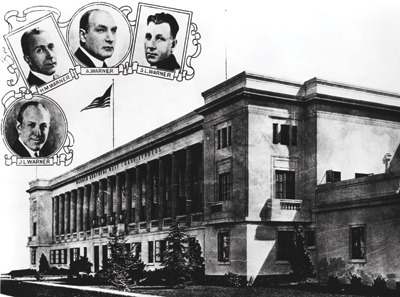 IN THE BEGINNING: The often factious Warner Brothers founded the studio in 1923. By
IN THE BEGINNING: The often factious Warner Brothers founded the studio in 1923. By
the '30s it was known as the place for gangster films and social dramas. (Credit: Warner Bros.)Schickel talks about the movie's first two hours largely because, at the time of the interview, it's the only segment finished. In a couple of days, cans in hand, he'll be jetting to Cannes for his first public viewings. But if he's nervous about it, he's not showing it. Instead, he projects the same frank calm he apparently brought to his initial "what-do-we-make-of-this" look at his raw material.
"I didn't have a theme as such in my mind when we started making this film," he says. "I was familiar enough with Warners. I probably knew most of the big films there," he says. "But the theme emerged from some of the interviews I had and from sitting in the cutting room or watching the movies at home."
Those interviews come from all over. Some are newly recorded sit-downs with the likes of critic Peter Rainer and writer Susan Orlean, who recently wrote a book on the studio's first big star, the German shepherd Rin Tin Tin. Modern-day directors, such as Martin Scorsese and longtime Warners presence Clint Eastwood (who, logically, narrates the movie), show up in the later sequences. Schickel was able to grab a few interview gems from TCM's archive (producer-director Mervyn LeRoy, for one).
But Schickel raided his own larder for some of the best archival interviews. The Men Who Made the Movies served up precious creative memories from directors who made crucial contributions to the Warners legacy, including Raoul Walsh, Howard Hawks, and Alfred Hitchcock.
From this stew of material one strong flavor came to dominate, especially during its first quarter-century.
"It was a real tough-minded studio," he says. You wouldn't in that era go to Warner Bros. for romantic comedies. They tried a few, but they weren't very good at it. They didn't have the actors for it and they didn't have the sensibility for it.
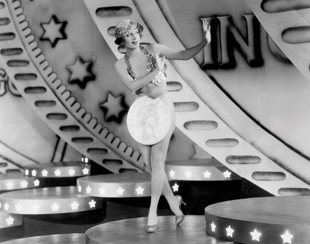 FROM THE VAULTS: Mervyn LeRoy's Gold Diggers of 1933.
FROM THE VAULTS: Mervyn LeRoy's Gold Diggers of 1933.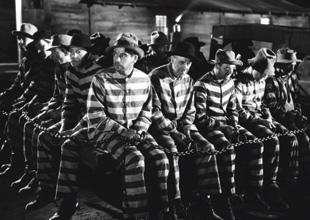 Mervyn LeRoy's I Am a Fugitive From a Chain Gang (1932).
Mervyn LeRoy's I Am a Fugitive From a Chain Gang (1932).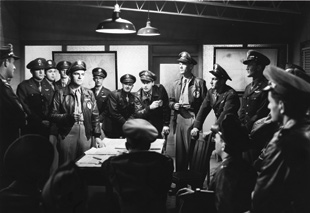 Howard Hawks' Air Force (1943), one of the studios' many war movies.
Howard Hawks' Air Force (1943), one of the studios' many war movies.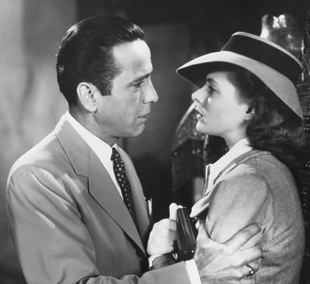 Perhaps the studio's signature film, Michael Curtiz's Casablanca (1942).
Perhaps the studio's signature film, Michael Curtiz's Casablanca (1942).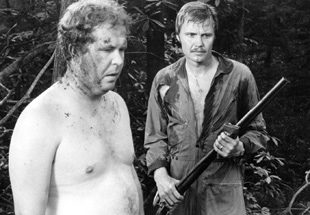 Ned Beatty and Jon Voight in John Boorman's Deliverance (1972).
Ned Beatty and Jon Voight in John Boorman's Deliverance (1972).
(Photo Credits: Photofest; last photo: AMPAS)"In Warners' films from the '30s and '40s there is this threatened American community," Schickel notes. "It's threatened by gangsters; it's threatened by the threat of war; it's threatened by war itself; it's threatened by the Ku Klux Klan; it's threatened by rampant American capitalism. It's all these things. And the kind of communitarian values of Warner Bros. shine through in all these different generic contexts."
Looking at this development retrospectively, Schickel deduces that this impulse came from two of the studio's production chiefs. Darryl Zanuck, who joined Warners in 1928 and was the head of production from 1929 to 1933, emphasized a gritty, if occasionally romanticized, realism that was evident in gangster films and social dramas epitomized in the work of director William Wellman (1931's The Public Enemy, 1933's Heroes for Sale); or, for that matter, in musicals choreographed by Busby Berkeley (Gold Diggers of 1933). Zanuck's successor, Hal Wallis, stayed at the studio until 1944, sustaining Zanuck's realistic streak, but also, says Schickel, "Wallis had a much more expansive, romantic sense of what movies could do, and once he got Flynn he could play all these swashbuckling, historical romances.
"The '30s movies were about good guys who stand for good liberal values, whether in stories set in the 18th century or modern times. During World War II, Warners was the great studio of the multiethnic American platoon. It could be in the air in Air Force (Howard Hawks, 1943) or on a ship in Action in the North Atlantic (Lloyd Bacon, 1943) or on land in Objective, Burma! (Raoul Walsh, 1945)–or wherever they were–there was always a Jewish guy, an Irish guy, a guy from the farm. That continuity of ordinary Americans under pressure, yet coming through and being democratic. I love it in Hollywood Canteen (1944) when Dane Clark gets to say, 'Big shots talkin' to little shots, that's what it's all about.'"
To help cement these somewhat abstract ideas to actual movies, Schickel links genres to the stars most closely associated with them. Thus a section called "Mob Rules," for example, is heavy with clips of studio stalwarts James Cagney and Edward G. Robinson, while "Breaking the Code," which overlaps the same time period, features Barbara Stanwyck and, believe it or not, Humphrey Bogart (seen cracking a cocaine joke). The approach makes You Must Remember This a lot of fun to watch and, according to Schickel to make. But when does the fun get in the way of history? When, in other words, is enough enough?
"It's all kind of grab-ass," Schickel admits. "I'll talk to my editor, Faith Ginsberg, and I'll say, 'These are the movies that I think we want for this section.' She'll say, 'Maybe–but what about such-and-so.' We'll talk that through–and I prefer to do it in three to five minute swatches of film, then move on to the next and the next and the next. There's a lot of back-and-forthing, taking stuff out, putting stuff in. But it's all kind of tactile in the cutting room. It's equally driven by images and what characters say in the course of the movies."
In Ginsberg, Schickel has found a kindred spirit. Like most good editors, when you ask her about cutting the film together, she doesn't talk exclusively, or even mostly, about technical issues. Rather, she explains how she has to be just as individually responsive to the raw material as Schickel is. While Schickel was giving his pre-Cannes interview, Ginsberg was down the hall from her director working on the '70s portion of You Must Remember This.
"We're cutting in small chunks," Ginsberg says of the piecemeal process, an approach that demands close collaboration. "Richard will say we have to look at a particular movie. For instance, I just did the Woodstock (Michael Wadleigh, 1970) sequence. We'll discuss, here's what we have to talk about in Woodstock and we'll talk about the interviews that we have, and the points we want to hit. Then I'll make a cut."
Listening to Schickel and Ginsberg talk to each other in half-sentences and murmurs, you can tell they are sharing the same wavelength. Which is a good thing, because in some ways, they're a couple of explorers blazing their own trail. And like a lot of guys, Schickel won't use a map.
"I never outline anything," Schickel says, emphatically. "I like to be surprised. It's boring if you're just filling in an outline. Then it makes you miss things. I like the improvisational quality of working the film with the editor. It's why we're behind. It's a slow process. This is my nature, it's how I do things. I write the script last.
"It's analogous to the way I write books. I gather a lot of material, I interview people, I study the literature. But then I just start writing [the book]. It baffles me how people outline something before they know what they're doing"
So far, Schickel has avoided going in circles. But there is the occasional cul-de-sac.
"Sometimes you have to be on the nose and sometimes it's better not to be," Ginsberg explains. "With Casablanca you have to show certain things. But with other movies, maybe you can show something different and tie it to what you're trying to say."
Such is the case with Deliverance (John Boorman, 1972). Instead of showing the movie's most commonly excerpted clips–the dueling banjos and, well, 'sooey!'–Schickel wants to try out new bits, in particular a scene where two of the stars, Jon Voight and Burt Reynolds, look over a valley and essentially discuss the movie's main theme, the nature of manhood.
That's when what Schickel calls the 'tactile' nature of editing intrudes. Somehow the Deliverance sequence is too slow and there's a lot to get in. Specifically, there's a snippet of an interview with John Calley, who, at the time of Deliverance, was the Warners production executive backing the film. The distinguished and well-liked Hollywood veteran has an amusing anecdote about pitching the movie to his boss, Ted Ashley, that has a serious point about the studio's responsiveness then to enthusiasm and risk-taking.
Schickel and Ginsberg watch Calley on their twin monitors after watching the Voight and Reynolds clip. They're not getting the pep they were hoping for. But, perhaps out of politeness and respect for Calley, they don't directly address the problem. Finally, they acknowledge it's taking Calley an awfully long time to tell such a little story.
So the director and editor return to the movie clip and another one they want to use, this one from the beginning rather than the end of the Ned Beatty rape scene. Suggestions are made on elisions and snips but, basically, it's back to the drawing board.
But You Must Remember This wasn't just a labor of love, or labor at all. Schickel spent hours watching movies served up from the extensive, perhaps even complete (at least in terms of the sound era), Warner film archives. Usually, he'd take an armful of half-inch videos home and spend hours in front of the TV. "It's time-consuming, but if you're into it, man, it's really fun. You see all kinds of weird stuff you didn't know about." For example, in the course of his viewing, Schickel stumbled across a group of 1930s-era films starring the once-popular, now-forgotten George Arliss. Schickel was so entranced by the talented, if somewhat hammy, balding, diminutive and homely actor that he momentarily dropped the movie's overarching structure and gave over a whole segment to Arliss' historical dramas.
"Another guy like me doing this film would probably put emphasis in different places," says Schickel the critic and filmmaker. "To that degree, there's a sort of authorship here. This is how it seems to me. You can argue with me, but the truth of the matter is I've seen an awful lot of these movies, and whatever positions I'm taking are just utterly defensible."